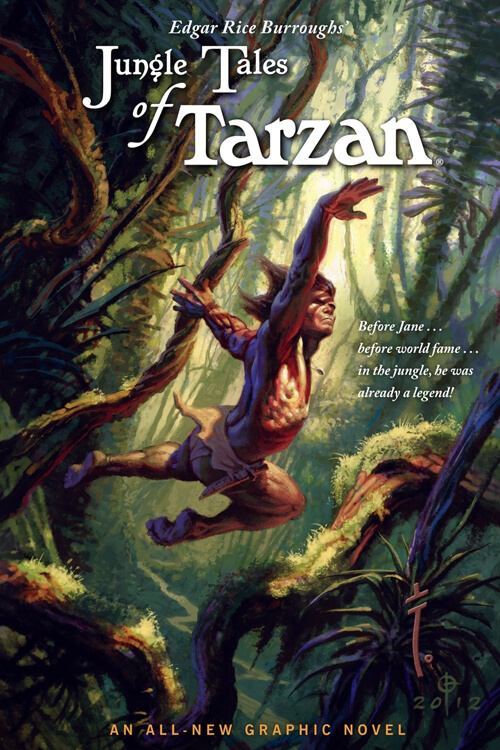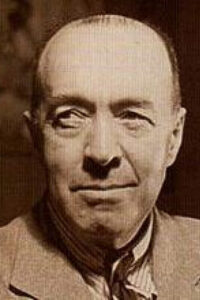
Jungle Tales of Tarzan
Tarzan’s First Love TEEKA, STRETCHED AT luxurious ease in the shade of the tropical forest, presented a most alluring picture of young, feminine loveliness. Or at least so thought Tarzan of the Apes, who squatted upon a low-swinging branch in a nearby tree and looked down upon her.
Just to have seen him there, lolling upon the swaying bough of the jungle-forest giant, his brown skin mottled by the brilliant equatorial sunlight that percolated through the leafy canopy of green above him, his clean-limbed body relaxed in graceful ease, his shapely head partly turned in contemplative absorption and his intelligent, gray eyes dreamily devouring the object of their devotion, you would have thought him the reincarnation of some demigod of old.
You would not have guessed that in infancy he had suckled at the breast of a hideous, hairy she-ape, nor that in all his conscious past since his parents had passed away in the little cabin by the landlocked harbor at the jungle’s verge, he had known no other associates than the sullen bulls and the snarling cows of the tribe of Kerchak, the great ape.
Nor, could you have read the thoughts which passed through that active, healthy brain, the longings and desires and aspirations which the sight of Teeka inspired, would you have been any more inclined to give credence to the reality of the origin of the ape-man. For, from his thoughts alone, you could never have gleaned the truth—that he had been born to a gentle English lady or that his sire had been an English nobleman of time-honored lineage.
Lost to Tarzan of the Apes was the truth of his origin.
That he was John Clayton, Lord Greystoke, with a seat in the House of Lords, he did not know, nor, knowing, would have understood.
Yes, Teeka was indeed beautiful!
Of course, Kala had been beautiful—one’s mother is always that—but Teeka was beautiful in a way all her own, an indescribable sort of way that Tarzan was just beginning to sense in a rather vague and hazy manner.
For years had Tarzan and Teeka been playfellows, and Teeka continued to be playful while the young bulls of her age were rapidly becoming surly and morose. Tarzan, if he gave the matter much thought at all, probably reasoned that his growing attachment for the young female could be easily accounted for by the fact that of the former playmates she and he alone retained any desire to frolic as of old.
Read or download Book
Edgar Rice Burroughs
Edgar Rice Burroughs (September 1, 1875 – March 19, 1950) was an American writer, best known for his prolific output in the adventure, science fiction, and fantasy genres. Best known for creating the characters Tarzan and John Carter, he also wrote the Pellucidar series, the Amtor series, and the Caspak trilogy. Tarzan was immediately popular, and Burroughs capitalized on it in every possible way, including a syndicated Tarzan comic strip, films, and merchandise. Tarzan remains one of the most successful fictional characters to this day and is a cultural icon. Burroughs’s California ranch is now the center of the Tarzana neighborhood in Los Angeles, named after the character. Burroughs was an explicit supporter of eugenics and scientific racism in both his fiction and nonfiction; Tarzan was meant to reflect these concepts.
Biography
Burroughs was born on September 1, 1875, in Chicago (he later lived for many years in the suburb of Oak Park), the fourth son of Major George Tyler Burroughs, a businessman, and Civil War veteran, and his wife, Mary Evaline (Zieger) Burroughs. His middle name is from his paternal grandmother, Mary Coleman Rice Burroughs. Burroughs was of almost entirely English ancestry, with a family line that had been in North America since the Colonial era. Through his Rice grandmother, Burroughs was descended from settler Edmund Rice, one of the English Puritans who moved to Massachusetts Bay Colony in the early 17th century. He once remarked: “I can trace my ancestry back to Deacon Edmund Rice.”
The Burroughs side of the family was also of English origin, having emigrated to Massachusetts around the same time. Many of his ancestors fought in the American Revolution. Some of his ancestors settled in Virginia during the colonial period, and Burroughs often emphasized his connection with that side of his family, seeing it as romantic and warlike. Burroughs was educated at several local schools. He then attended Phillips Academy, in Andover, Massachusetts, and then the Michigan Military Academy. After graduating in 1895, but failing the entrance exam for the United States Military Academy at West Point, he instead became an enlisted soldier with the 7th U.S. Cavalry in Fort Grant, Arizona Territory. After being diagnosed with a heart problem and thus ineligible to serve, he was discharged in 1897.
After his discharge, Burroughs worked at several different jobs. During the Chicago influenza epidemic of 1891, he spent half a year at his brother’s ranch on the Raft River in Idaho, as a cowboy, drifted somewhat afterward, then worked at his father’s Chicago battery factory in 1899, marrying his childhood sweetheart, Emma Hulbert (1876–1944), in January 1900. In 1903, Burroughs joined his brothers, Yale graduates George and Harry, who were, by then, prominent Pocatello area ranchers in southern Idaho, and partners in the Sweetser-Burroughs Mining Company, where he took on managing their ill-fated Snake River gold dredge, a classic bucket-line dredge. The Burroughs brothers were also the sixth cousins, once removed, of famed miner Kate Rice who, in 1914, became the first female prospector in the Canadian North. Journalist and publisher C. Allen Thorndike Rice was also his third cousin. When the new mine proved unsuccessful, the brothers secured for Burroughs a position with the Oregon Short Line Railroad in Salt Lake City. Burroughs resigned from the railroad in October 1904.
Later life
By 1911, around age 36, after seven years of low wages as a pencil-sharpener wholesaler, Burroughs began to write fiction. By this time, Emma and he had two children, Joan (1908–1972), and Hulbert (1909–1991). During this period, he had copious spare time and began reading pulp fiction magazines. In 1929, he recalled thinking that:
“[…] if people were paid for writing rot such as I read in some of those magazines, that I could write stories just as rotten. Although I had never written a story, I knew absolutely that I could write stories just as entertaining and probably a whole lot more so than any I chanced to read in those magazines.”
In 1913, Burroughs and Emma had their third and last child, John Coleman Burroughs (1913–1979), later known for his illustrations of his father’s books. In the 1920s, Burroughs became a pilot, purchased a Security Airster S-1, and encouraged his family to learn to fly. Daughter Joan married Tarzan film actor James Pierce. She starred with her husband as the voice of Jane, during 1932–1934 for the Tarzan radio series. Burroughs divorced Emma in 1934, and, in 1935, married the former actress Florence Gilbert Dearholt, who was the former wife of his friend (who was then himself remarrying), Ashton Dearholt, with whom he had co-founded Burroughs-Tarzan Enterprises while filming The New Adventures of Tarzan. Burroughs adopted the Dearholts’ two children. He and Florence divorced in 1942.
Burroughs was in his late 60s and was in Honolulu at the time of the Japanese attack on Pearl Harbor. Despite his age, he applied for and received permission to become a war correspondent, becoming one of the oldest U.S. war correspondents during World War II. This period of his life is mentioned in William Brinkley’s bestselling novel Don’t Go Near the Water.






